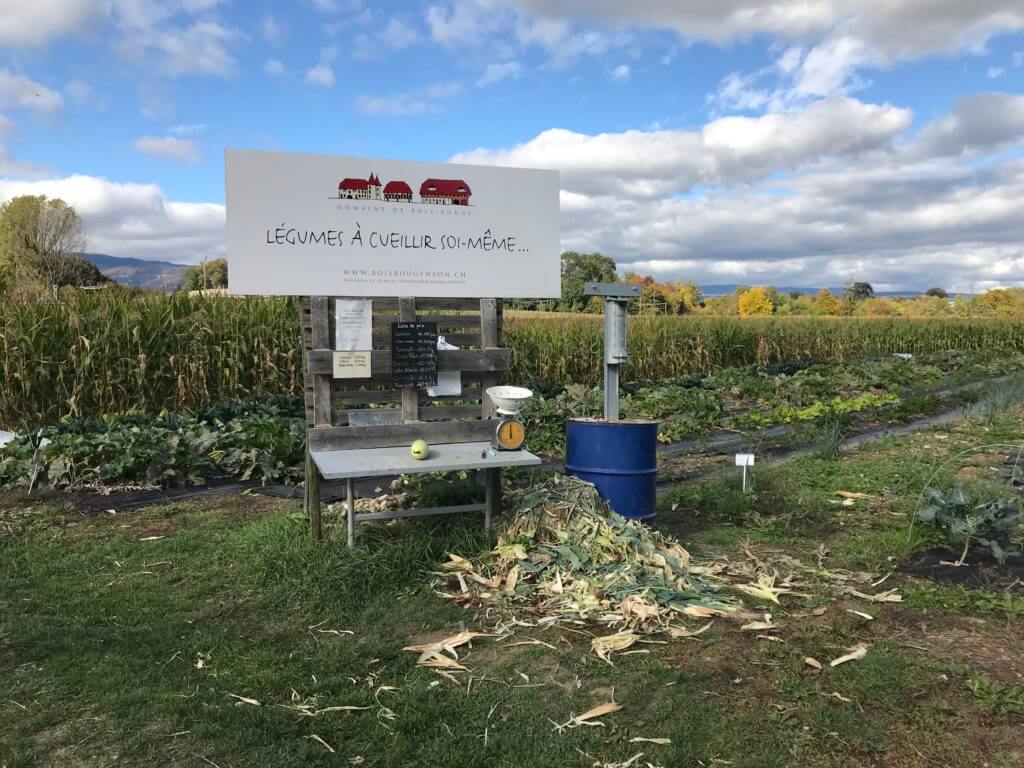TRAVEL: A Walk Through Eysins

Families at the playground. Walking paths. Houses and apartments clustered together. Farming all around.
These are some of the elements that impressed me on a recent early evening walk through the tiny town of Eysins, Switzerland, population 1,600. We were staying nearby in Nyon, a city founded by the Romans in 50 BCE on the shore of Lake Geneva. A five-minute walk took me out of the city and into the countryside, where I found a gravel path through cabbage fields recently plowed and cover-cropped. A couple and small child strolled by; a man walked his dog up ahead; two women were picking up walnuts under trees by the nearby river. Light from the sinking sun highlighted the snow on Mont Blanc in the French Alps, visible off in the distance.
A few more minutes of walking brought me into the village. Closest to the fields were newer buildings. There was a modest condominium development and several attractive apartment buildings. At two to four stories high, with pleasant landscaping and flower-filled balconies overlooking the fields, their architecture and rooflines blended in with the older homes and farm buildings. Our host explained later that there is a high demand for homes in small communities, but real estate prices are very high. Families and young professionals are seeking a pleasanter environment than the urban life of Geneva, just 15 miles to the south, and Lausanne 30 miles to the north. The demand is being filled with multi-family buildings tucked into the scarce land within town and city boundaries. The surrounding farmland and vineyards continue to produce an abundance of vegetables, sugar beets and wine, and provide pasture for dairy cows, sheep and horses.
The town center was just two blocks from the fields. A few people were sitting at tables set up in the square ready for a harvest festival the next day. They were sharing cheese and a bottle of wine purchased at the market, which was one of four small shops in the adjacent building. I could hear the sound of children nearby and found them in a large playground on the far side of the building. Small groups of parents were chatting and laughing as their children played with their friends. A school and soccer field were behind the playground, a community billboard was posted with notices and event posters. A 20-plot community garden and the town office building completed the scene.
I walked back to the field through a neighborhood with single family homes, some new, some much older. The street was one car-width wide, and lots were small. Most yards were full of flowers and small vegetable gardens; sheep pastured in an adjacent lot. A busy road from Geneva was a few blocks away, but the atmosphere was very peaceful.
As I walked back to Nyon, I thought about the differences between Eysins and Charlotte. Switzerland has the distinctly European settlement pattern of densely populated villages and cities surrounded by open farmland, vineyards and orchards. This pattern goes back centuries to when people lived close together for protection within walled fortresses. The surrounding land was owned by the squire or lord or other wealthy family that kept it intact and farmed by tenant farmers.
Our history is very different. The independent New Englanders who settled Vermont cleared, lived on and farmed land that they owned. Early maps of Charlotte show most of the town divided into lots of hundreds of acres. The villages consisted of smaller lots where businesses like taverns, stores and blacksmiths were located and their owners lived. Over the years many of the large lots were subdivided, and smaller homesteads and developments have replaced big farms. The pattern continues of scattered development with mostly five- to10-acre lots spread across town.
The Charlotte Town Plan has consistently urged residents to funnel new growth into our village centers rather than continuing to subdivide the open spaces. Why hasn’t that happened?
Perhaps it would help to have a clearer vision of Charlotte’s future. My walk through Eysins offers a hint of what that could be. Imagine what it would be like in our West and East Villages if there were playgrounds at the centers, with safe walking and biking paths leading to them and to the stores, library, Senior Center, Town Hall, Grange and church. Imagine a small condominium complex and attractive apartment buildings designed to blend with the architecture of the older homes. Imagine the young families and seniors who could afford to live there and who would add to the vitality of our school and community.
And moving even farther outside the box, imagine such a settlement in the area near our central—but isolated—school, where there are already fine recreational and community facilities.
Like Eysins, Charlotte is nestled in a lovely valley, with spectacular views of open fields, beautiful lake, rivers and mountains. Both are home to farmers who are leaders in the local foods movement, offering fresh meats and vegetables. Our Town Plan protects and encourages these assets and has been fully supported by Charlotters. But our school enrollment is declining; our population is aging; jobs are scarce in town; it is unsafe to walk on the busier roads; and the little growth that there is divides up the countryside.
Imagine a future for Charlotte where these trends are reversed.

